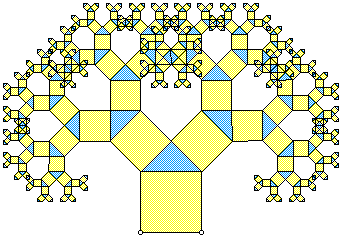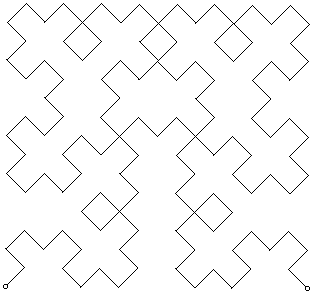

Included here are a few odds and ends of interest to me. Above is a fractal that Mo Hendon in the UGA Math Dept asked me to construct using Geometer's Sketchpad (GSP). It is alled a Pythagorean tree. If you have GSP, you can download the following picture and/or script:
Fractals can also be generated on spreadsheets using Iterated Function Systems (IFS). The following file illustrates how an IFS may be encoded as a set of matrices, which are randomly selected at each iteration of a point. The matrices are entered as augmented matrices, where the e and f entries represent translations in the x and y directions, respectively. This process will be explained more clearly in the ICTCM paper, on which I am currently working.
The second file develops Julia Sets in the complex plane in a manner similar to IFS. It uses the inverse of the recursive finction X(n+1)=X(n)^2+C, for which the Julia set an attractor.

Finally, here is my analysis of the game of pigs. This is a dice-rolling game derived from "Pass the Pigs" (available in toy stores everywhere!). The idea is that 2 people compete in a die-rolling game. Anytime a person avoids rolling a 1, he or she receives points equal to the value of the die. Points accumulate for each round until a person decides not to press her/his luck and "passes the pig" or until a 1 is rolled, in which case all points in the round for that person are lost. Now, the second person has her/his turn completing the round. What is the best strategy? Should you stop after 4 rolls? 5? 25 points? This spreadhseet demonstrates some of the analysis, and will be written-up at some later date.